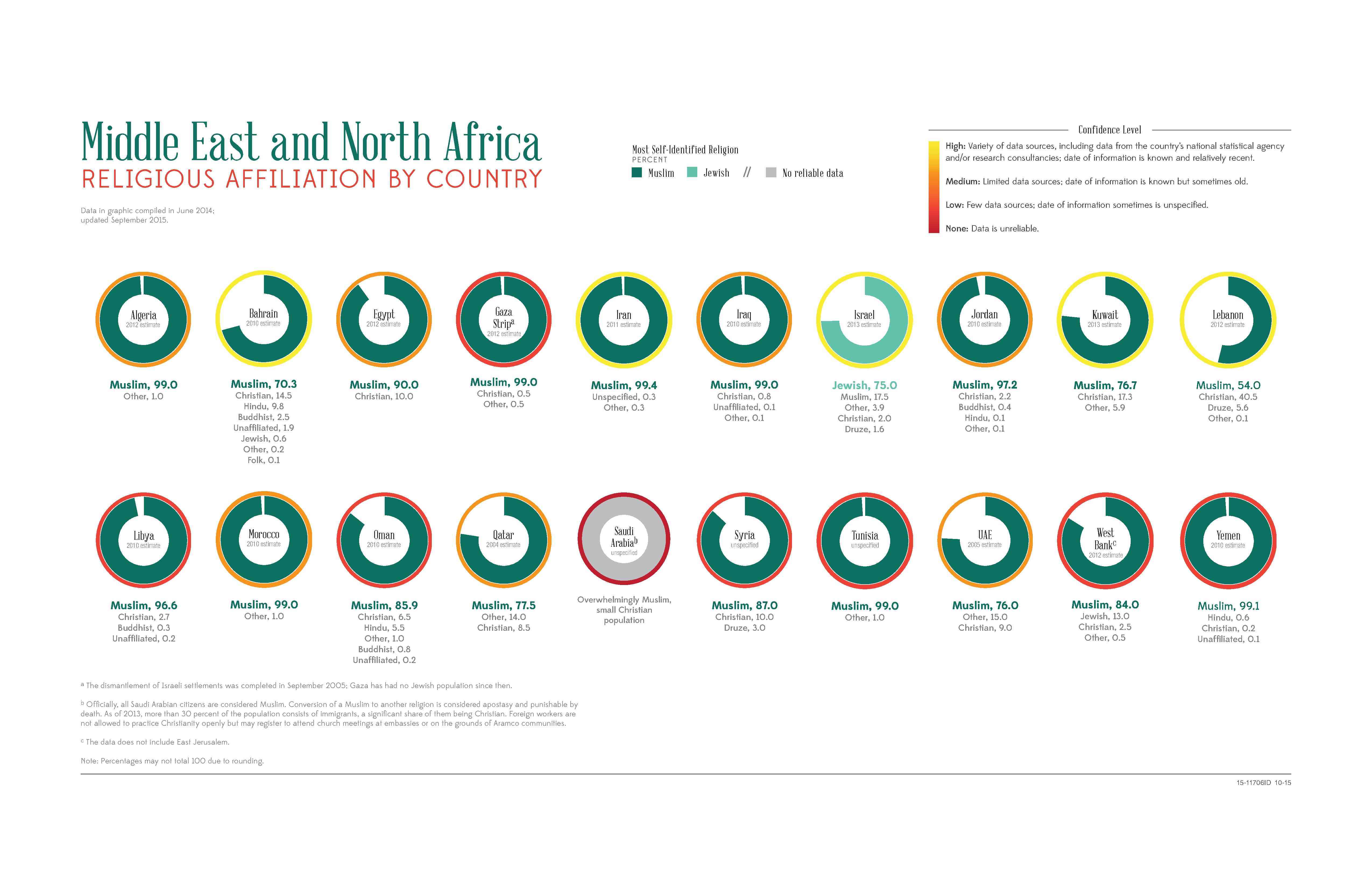
9,043,387 (2023 est.) (includes populations of the Golan Heights or Golan Sub-District and also East Jerusalem, which was annexed by Israel after 1967)
note: approximately 236,600 Israeli settlers live in East Jerusalem (2021); following the March 2019 US recognition of the Golan Heights as being part of Israel, The World Factbook no longer includes Israeli settler population of the Golan Heights (estimated at 23,400 in 2019) in its overall Israeli settler total
noun: Israeli(s)
adjective: Israeli
Jewish 73.5% (of which Israel-born 79.7%, Europe/America/Oceania-born 14.3%, Africa-born 3.9%, Asia-born 2.1%), Arab 21.1%, other 5.4% (2022 est.)
Hebrew (official), Arabic (special status under Israeli law), English (most commonly used foreign language)
major-language sample(s):
ספר עובדות העולם, המקור החיוני למידע בסיסי (Hebrew)
The World Factbook, the indispensable source for basic information.
Hebrew audio file:
Jewish 73.5%, Muslim 18.1%, Christian 1.9%, Druze 1.6%, other 4.9% (2022 est.)

0-14 years: 25.96% (male 1,200,721/female 1,146,556)
15-64 years: 61.66% (male 2,839,124/female 2,737,054)
65 years and over: 12.38% (2023 est.) (male 506,536/female 613,396)
total dependency ratio: 66.9
youth dependency ratio: 47
elderly dependency ratio: 19.9
potential support ratio: 5 (2021 est.)
total: 30.1 years (2023 est.)
male: 29.5 years
female: 30.7 years
1.56% (2023 est.)
19.3 births/1,000 population (2023 est.)
5.6 deaths/1,000 population (2023 est.)
1.9 migrant(s)/1,000 population (2023 est.)
population concentrated in and around Tel-Aviv, as well as around the Sea of Galilee; the south remains sparsely populated with the exception of the shore of the Gulf of Aqaba
urban population: 92.9% of total population (2023)
rate of urbanization: 1.51% annual rate of change (2020-25 est.)

4.421 million Tel Aviv-Yafo, 1.174 million Haifa, 970,000 JERUSALEM (capital) (2023)
at birth: 1.05 male(s)/female
0-14 years: 1.05 male(s)/female
15-64 years: 1.04 male(s)/female
65 years and over: 0.83 male(s)/female
total population: 1.01 male(s)/female (2023 est.)
27.7 years (2019 est.)
3 deaths/100,000 live births (2020 est.)
total: 3 deaths/1,000 live births (2023 est.)
male: 3.6 deaths/1,000 live births
female: 2.5 deaths/1,000 live births
total population: 82.2 years (2023 est.)
male: 80.2 years
female: 84.3 years
2.94 children born/woman (2023 est.)
1.44 (2023 est.)
N/A
improved: urban: 100% of population
rural: 100% of population
total: 100% of population
unimproved: urban: 0% of population
rural: 0% of population
total: 0% of population (2020 est.)
8.3% of GDP (2020)
3.63 physicians/1,000 population (2020)
3 beds/1,000 population (2018)
improved: urban: 100% of population
rural: 99.3% of population
total: 99.9% of population
unimproved: urban: 0% of population
rural: 0.7% of population
total: 0.1% of population (2020 est.)
note: on 31 August 2023, the US Centers for Disease Control and Prevention (CDC) issued a Travel Alert for polio in Asia; Israel is currently considered a high risk to travelers for circulating vaccine-derived polioviruses (cVDPV); vaccine-derived poliovirus (VDPV) is a strain of the weakened poliovirus that was initially included in oral polio vaccine (OPV) and that has changed over time and behaves more like the wild or naturally occurring virus; this means it can be spread more easily to people who are unvaccinated against polio and who come in contact with the stool or respiratory secretions, such as from a sneeze, of an “infected” person who received oral polio vaccine; the CDC recommends that before any international travel, anyone unvaccinated, incompletely vaccinated, or with an unknown polio vaccination status should complete the routine polio vaccine series; before travel to any high-risk destination, the CDC recommends that adults who previously completed the full, routine polio vaccine series receive a single, lifetime booster dose of polio vaccine
26.1% (2016)
total: 3.07 liters of pure alcohol (2019 est.)
beer: 1.78 liters of pure alcohol (2019 est.)
wine: 0.08 liters of pure alcohol (2019 est.)
spirits: 1.16 liters of pure alcohol (2019 est.)
other alcohols: 0.04 liters of pure alcohol (2019 est.)
total: 21.2% (2020 est.)
male: 28.9% (2020 est.)
female: 13.5% (2020 est.)
N/A
51.7% (2023 est.)
7.1% of GDP (2020 est.)
definition: age 15 and over can read and write
total population: 97.8%
male: 98.7%
female: 96.8% (2011)
total: 16 years
male: 15 years
female: 17 years (2020)
NOTE: The information regarding Israel on this page is re-published from the 2024 World Fact Book of the United States Central Intelligence Agency and other sources. No claims are made regarding the accuracy of Israel 2024 information contained here. All suggestions for corrections of any errors about Israel 2024 should be addressed to the CIA or the source cited on each page.
This page was last modified 04 May 24, Copyright © 2024 ITA all rights reserved.